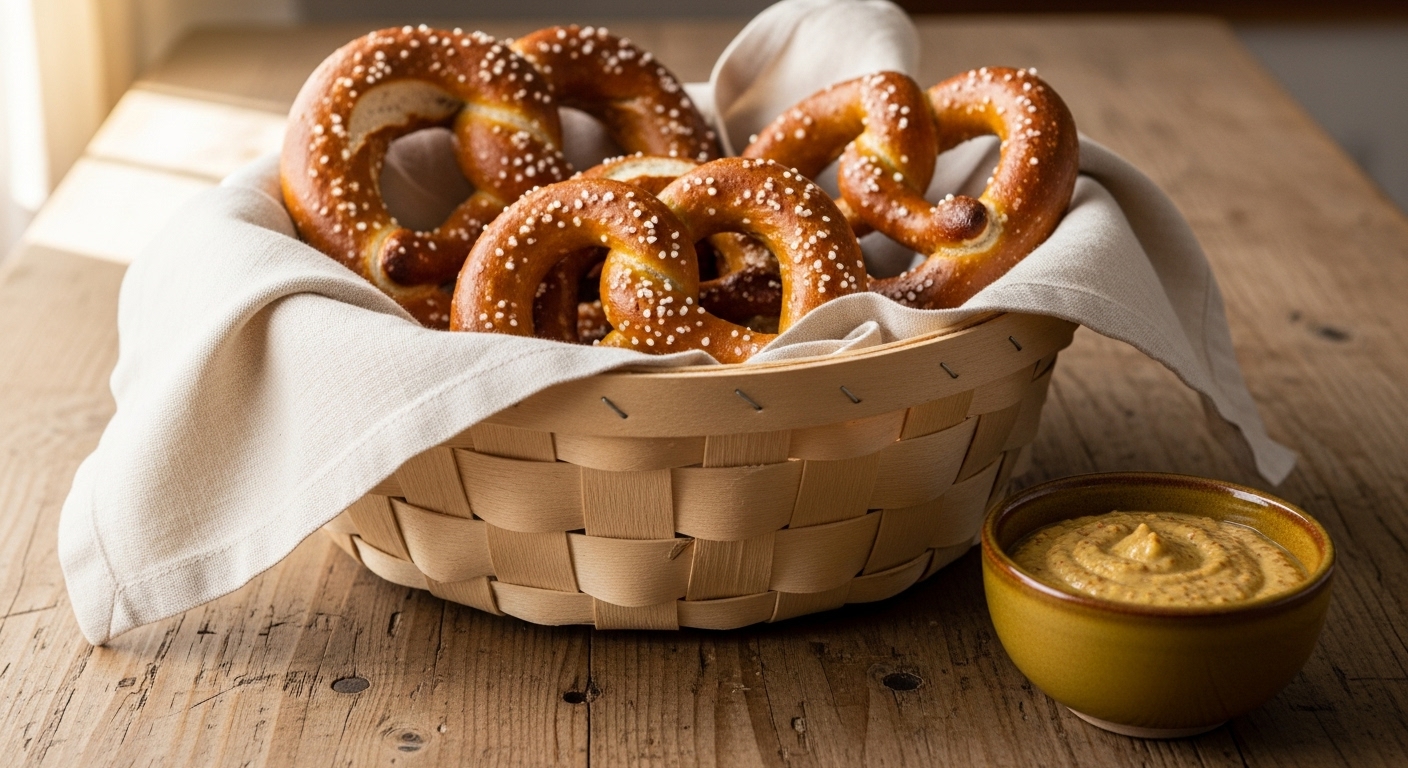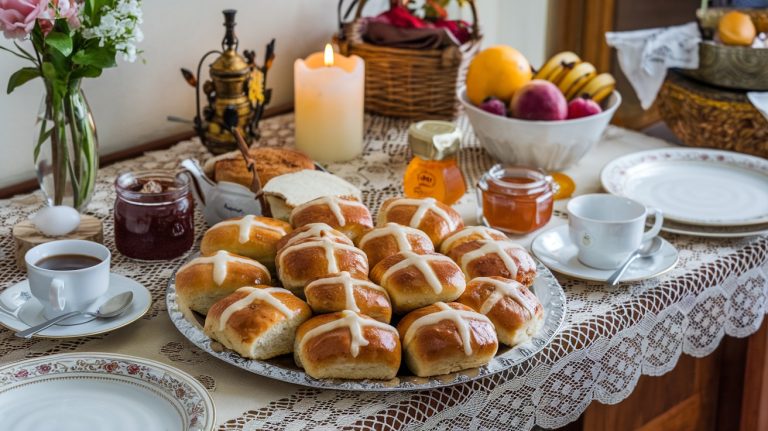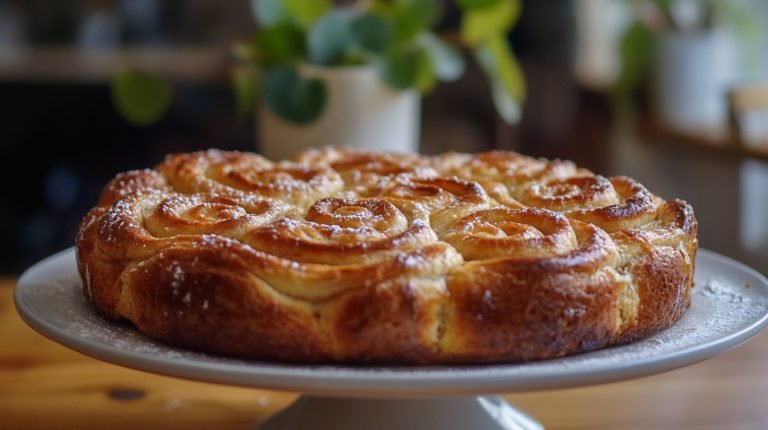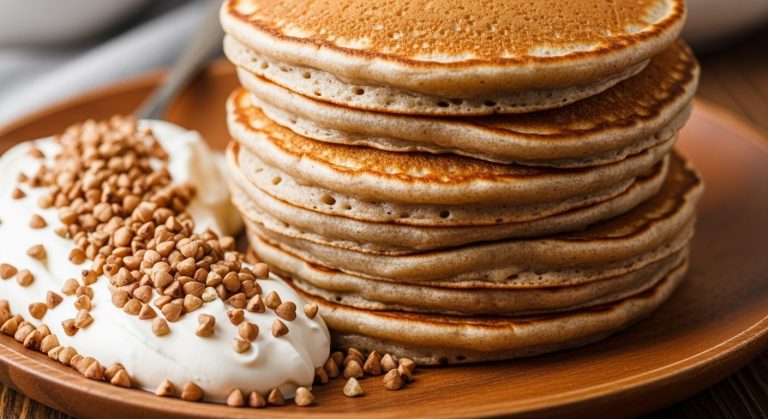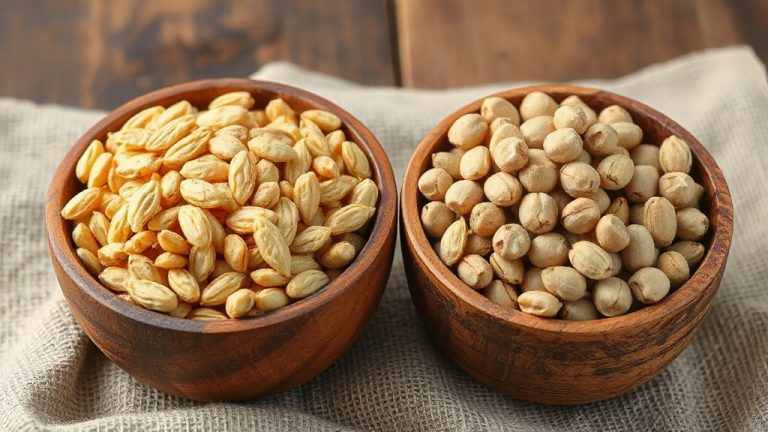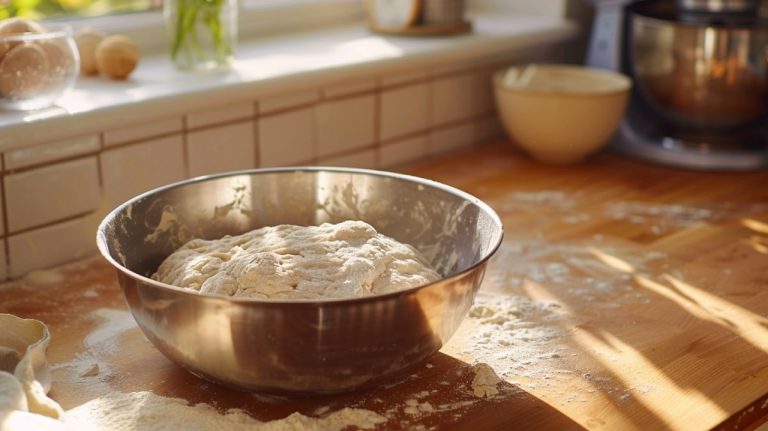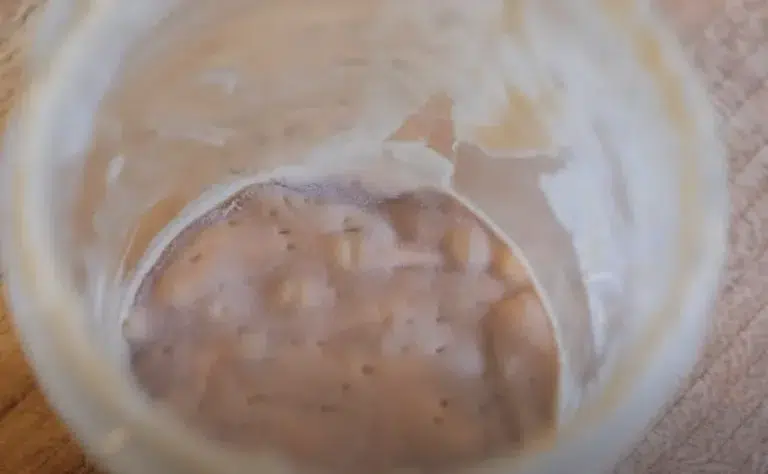Sourdough Discard Pretzel Recipe for Deliciously Soft & Chewy Bites
Turn your sourdough discard into tender, tangy soft pretzels by mixing discard with lukewarm water, a pinch of sugar, instant yeast, flour, salt and a bit of butter; knead until smooth, let it rest briefly, then divide and roll into ropes.
Boil each pretzel 20–30 seconds in baking-soda water for that mahogany crust, top with coarse salt or seasonings, and bake at 425°F until glossy and browned. Keep going to get exact timings, tips, and variations.
Key Takeaways
- Use sourdough discard to add mild tang, reduce waste, and keep quick rises using a small amount of instant yeast.
- Typical dough: ~4 cups flour (560 g), 60–65% hydration, 200–285 g discard, salt, sugar, and melted butter.
- Knead 7–10 minutes until smooth; bulk ferment 20 minutes with yeast (or 3–3.5 hours if discard-only).
- Portion ~130 g pieces, roll 18–24″ ropes, shape classic pretzels, rest 30–60 minutes to puff before boiling.
- Boil 10–30 seconds per side in water with baking soda, top with salt, then bake 400–450°F for 12–18 minutes.
Easy Homemade Sourdough Discard Pretzel Recipe
| Ingredient | Measurement Range | Purpose |
|---|---|---|
| All-Purpose/Bread Flour | ~560 g (≈4 cups) | Base structure; bread flour adds extra chew |
| Sourdough Discard | 200–285 g (100% hydration) | Tangy flavor, improved texture, waste reduction |
| Lukewarm Water | 236–270 g (1–1 ⅛ cups) | Hydration; activates yeast |
| Instant Yeast | 1–2 tsp | Ensures reliable rise with discard |
| Sugar or Honey | 1 tbsp–50 g | Feeds yeast, aids browning, balances tang |
| Salt | 2–8 g (½–1 ½ tsp) | Enhances flavor, controls fermentation |
| Butter (unsalted) | 2–4 tbsp (28–56 g) | Adds tenderness, richness, and sheen |
| Baking Soda (for boil) | ~¼ cup per 2 quarts water | Creates mahogany crust, chewy bite |
| Egg Wash / Alternatives | 1 egg yolk + 1 tbsp water | Glossy finish, helps toppings stick |
| Toppings (Salt/Seeds) | To taste | Flavor, texture, visual appeal |
Why Use Sourdough Discard in Pretzels?
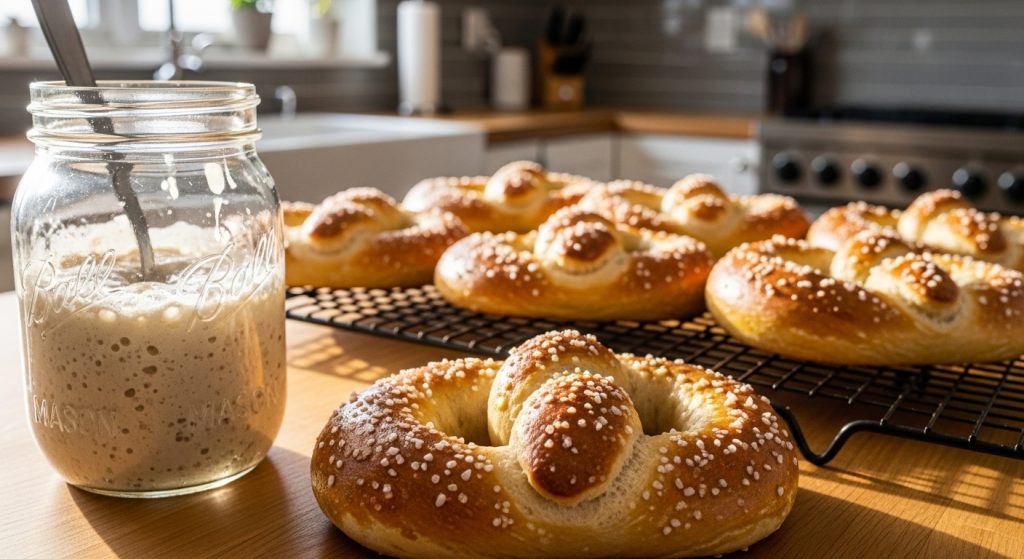
Why not put that excess starter to work? You’ll reduce food waste by folding discard into pretzel dough instead of tossing it, turning overripe culture into flavor and value.
You’ll get a gentle tang—sourdough character without long fermentation—so your pretzels taste more complex than plain ones. Discard also alters hydration and acidity, improving chew, tenderness, and dough extensibility while still letting you use commercial yeast for a quicker rise.
That flexibility means you can bake without an active, bubbly starter and still capture sourdough benefits like enhanced digestibility, enzyme activity, and modest shelf-life extension. It’s economical, sustainable, and user-friendly—ideal if you want distinct sour notes, better texture, and smarter use of every jar of starter.
Using discard is also a great way to avoid waste and make tasty snacks while saving money and resources sourdough discard. You can also customize mix-ins and baking times to tweak texture and flavor for longer shelf-life.
Essential Ingredients You’ll Need
You’ll want to understand the difference between an active starter and unfed discard, since discard provides flavor without needing a feeding. Pay attention to flour type and hydration—bread flour and slightly higher water give chew, while adjust water to match your discard’s consistency.
Don’t forget salt for control and flavor, a bit of sugar to feed the yeast and boost browning, and butter for richness and tenderness. Using discard speeds up prep and reduces waste, making it a great option for home bakers who want reliable results with minimal effort sourdough discard benefits.
For a crisper crust and better oven spring, consider baking the pretzels in a preheated Dutch oven.
Starter vs. Discard
Wondering whether to reach for your fed starter or the discard jar when making pretzels? If you want natural lift and deeper tang, use an active starter — it’ll leaven without commercial yeast but needs long fermentation and patience.
Discard shines when you want convenience: it adds mild sour flavor, cuts waste, and pairs with instant yeast for a quick, reliable rise. Choose starter for chewier texture and pronounced sour notes; choose discard for faster mixing, predictable handling, and a tender crumb.
Consider your schedule, flavor goals, and comfort with starter maintenance when deciding.
- Pride in rescuing discard into something delicious
- Satisfaction of watching wild yeast work slowly
- Relief from a quick, reliable bake with commercial yeast
- Anticipation of deeper sour complexity
- Joy in reducing waste while baking
- You can use discard straight from the refrigerator without feeding it for this recipe because it works well with instant yeast.
- This recipe adapts well to whole-grain flours like hard white spring wheat berries for added nutrition and a nuttier flavor.
Flour and Hydration
After you decide whether to use active starter or discard, the next big choices are the flour and how much liquid you’ll feed the dough. You’ll most often reach for unbleached all-purpose—about 4 cups (≈560 g)—for a reliable balance of elasticity and tenderness.
If you want more chew, swap to bread flour (around 390 g) or blend bread flour with whole milk for softness and flavor. Hydration usually sits near 60–65%: roughly 236–270 g water per 4 cups flour, adjusted if you add 200–285 g discard, since discard is ~100% hydration and reduces added water and flour.
Use room-temperature water (or milk) for gentle activation. Tweak hydration to control stickiness, shaping ease, and the pretzel’s final chew and crumb. You can also enrich the dough with butter and sugar to create a softer, richer pretzel.
Many home bakers appreciate mixes that simplify the process and offer long shelf life, such as sourdough mix shelf life, when planning batch prep and storage.
Salt, Sugar, Butter
A few simple ingredients—salt, sugar, and butter—do a lot of heavy lifting in sourdough discard pretzels, shaping flavor, fermentation, and texture. You’ll use a modest pinch of salt in the dough (about 2–8 g) to tighten gluten, balance sweetness, and keep yeast in check. Sugar—brown sugar or honey—feeds the yeast, speeds rise, and deepens crust color; adjust 1 tbsp to 50 g depending on sweetness and discard acidity.
Butter (unsalted) adds richness and tender crumb; melt for the dough or brush softened butter on hot pretzels for shine. Using a bit of sourdough discard brings tangy depth and enhances overall flavor. Many bakers find that following basic proofing temperature guidelines helps achieve consistent rise and crumb.
- Warm, caramelized crust that makes you smile
- Chewy interior with satisfying pull
- Balanced savory-sweet bite
- Golden, glossy finish
- Comfort in every bite
Activating Yeast With Discard
How do you bring life back to sleepy discard? You feed it: equal weights of flour and water, then rest it 4–12 hours in a warm spot (70–80°F/21–27°C). Watch for bubbling and doubling—that’s yeast waking and producing gas.
If you don’t have time, don’t rely on discard alone; its yeast are mostly dormant and won’t provide reliable leavening. Instead, hydrate commercial yeast in warm (not hot) water for at least five minutes, then combine with your discard to ensure predictable rise and a lively crumb.
Using a scale with 1 gram precision helps you measure feedings and commercial yeast accurately for consistent results. Use the float test on fed discard to confirm activity.
Remember, warm temperatures speed activation, while water above ~120°F can kill yeast, so keep things comfortably warm, not scorching. Also, note that an active starter typically shows bubbling and will double in size within 4–12 hours after feeding, indicating it’s at peak leavening power.
Mixing and Kneading the Dough
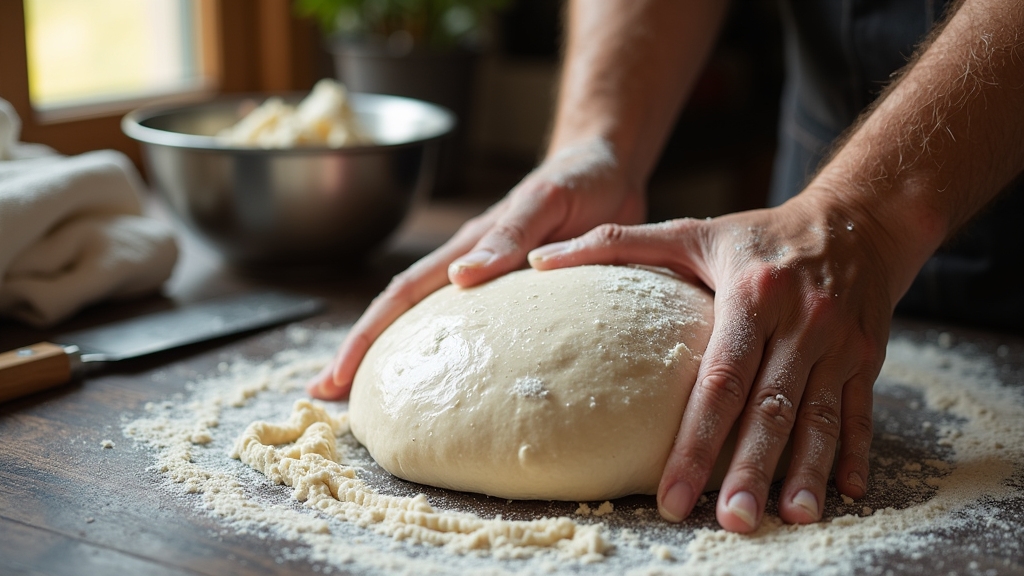
Wondering how to get your discard, water, and butter to turn into a smooth, springy pretzel dough? You’ll dissolve discard, lukewarm water, and sugar first, then add flour, salt, and melted butter gradually.
Mix on low—stand mixer with a dough hook gives the most even incorporation, but you can hand-mix if you’re careful. Watch the mass: no dry patches, no gooey puddles.
Knead about 7–10 minutes on a lightly floured surface or medium mixer speed until the dough’s smooth, elastic, and slightly tacky. Use the windowpane test to confirm readiness.
Keep temperatures moderate, avoid overheating, and cover the bowl after kneading so the dough stays pliable and ready for shaping. Adding a bit of instant yeast helps ensure a reliable rise alongside the discard instant yeast.
For best structure and oven spring, consider using bread flour to provide extra gluten strength.
- Anticipation of warm, buttery aroma
- Satisfaction from a silky dough
- Quiet focus of folding
- Joy in rising elasticity
- Pride in touchable progress
Bulk Fermentation Tips and Timing
While the dough rests, keep a close eye on temperature and feel. Bulk fermentation at about 74–76°F (23–24°C) will usually take 3 to 3.5 hours for discard-only dough, but adding commercial yeast can chop that down to roughly 20 minutes, so don’t rely on the clock alone.
Watch for a slightly puffy, domed surface and a smooth skin; gentle fingertip impressions should slowly spring back. At roughly 1 hour, do a set of stretch-and-folds to build strength; in slower ferments, repeat two more times at 30-minute intervals.
Keep the dough tightly covered to prevent skinning, especially with lower hydration. Higher temps speed activity but risk over-proofing, so adjust timing to ambient conditions and levain vigor rather than strict minutes.
Also remember that this recipe uses 55.0% hydration, which affects handling and final texture. For a chewier final product, consider using bread flour to increase gluten development.
Dividing, Rolling, and Shaping Pretzels
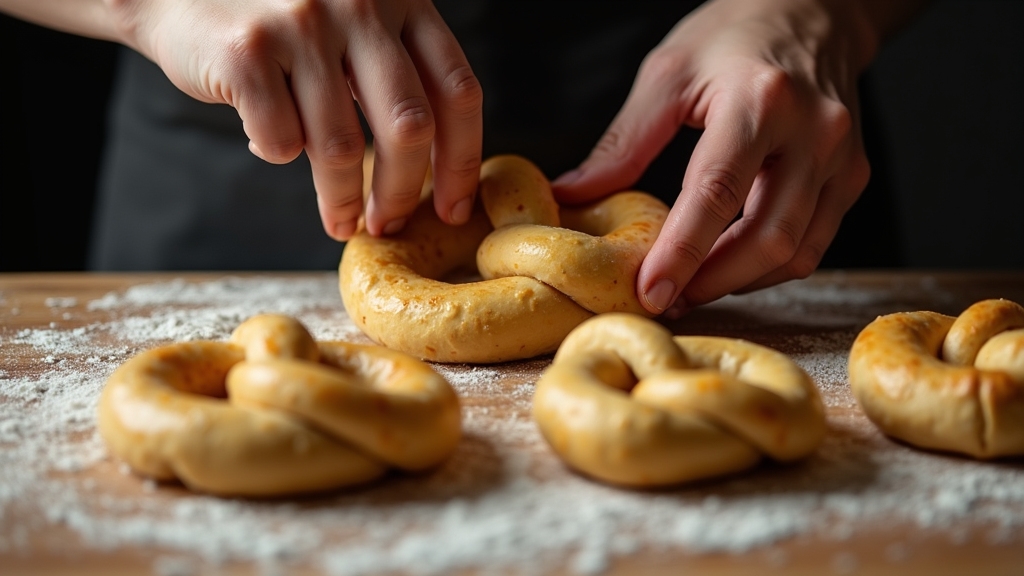
Now that your dough’s finished fermenting, you’ll portion it into equal pieces—use a bench scraper and aim for consistent weights (about 130 g for an 8-piece batch) so your pretzels bake uniformly. Consider using a 4–5 quart bowl for dough handling to allow room for expansion and ease of mixing.
Roll each piece into a smooth 18–24 inch rope on a lightly floured surface, keeping thickness even and shaking off excess flour before shaping.
Form the classic U, cross the ends twice, and press them into the curve firmly but gently so they hold through the soda bath and bake. Make sure to divide dough into 12 equal pieces if you prefer the standard batch size.
Portioning the Dough
How do you turn a single batch of sourdough discard dough into evenly sized pretzels? Start on a lightly floured or clean surface, divide the risen dough into eight roughly 130 g pieces (or four for bites), using a scale or a steady eye. Keep hands damp, not floury, to roll each piece into an 18–24 inch rope with even thickness.
For classic twists, form a U, cross and twist the ends, and press them firmly to seal without tearing. Work gently to avoid degassing, cover portions to prevent skinning, and have tools ready to move quickly from portioning to shaping.
Remember that a brief rest of about 5–10 minutes after portioning helps relax the gluten for easier shaping, which is especially useful when working with sourdough discard. Regular feeding and maintenance help keep a starter active and healthy so your discard performs reliably.
Forming Classic Shapes
With your dough portioned and resting, it’s time to roll and shape each piece into the classic pretzel form. Take a portion and, with slightly damp hands, roll it on an un-floured or lightly floured surface into an even rope about 18–24 inches long.
Keep thickness consistent so baking is uniform; avoid excess flour to preserve elasticity. Bend the rope into a U, cross the ends over twice for the traditional twist, then press and pinch the ends firmly to the base of the U so they won’t unravel.
Place shaped pretzels on parchment or a silicone mat, cover to prevent drying, and let them rest 30–60 minutes to puff before boiling. Handle gently after boiling to protect the shape. For a chewier texture, consider using bread flour in part or all of the dough.
The Baking Soda Boil: How and Why?
Why does a quick dip in an alkaline bath make such a big difference for pretzels? You dunk shaped dough briefly in simmering water with baking soda to raise surface pH, which alkalizes starches and proteins.
That shift accelerates the Maillard reaction during baking, producing the deep brown color, glossy crust, and toasty, savory flavors you expect. The bath also creates tiny gas bubbles and alters moisture retention, giving a chewy interior with a crisp exterior.
Timing matters—usually 10–30 seconds per side—and you remove with a slotted spoon to drain before baking. You can intensify results by converting baking soda to washing soda first for stronger alkalinity, safer than lye yet closer to traditional pretzels.
This works because baking soda interacts with acids to produce carbon dioxide, helping achieve lift and texture.
- Anticipation of that first bite
- Pride in a glossy crust
- Comfort in chewy warmth
- Surprise at complex flavor
- Satisfaction in craftmanship
Egg Wash, Toppings and Seasoning Options
That alkaline bath gives you the signature crust and color, and the egg wash and toppings are what finish the look and flavor—think of them as the outfit your pretzel wears out of the oven. Use a traditional egg yolk wash (1 yolk + 1 tbsp water) for deep, glossy brown; whole egg beaten with water or milk gives balanced sheen; egg white yields shinier, lighter brown.
For egg-free options, brush milk, cream, or olive/avocado oil. Apply wash after proofing, right before baking, so salt and seeds stick.Classic coarse pretzel salt defines the bite; flaky sea salt is subtler.
Try sesame, poppy, cracked pepper, garlic flakes, or cinnamon sugar (brush with butter post-bake). Combine seeds and salt for texture, and mind allergies and sodium. Bread flour gives the best chewy texture for traditional pretzels.
Baking Temperatures and Timing Guide
You’ll want to set your oven between 400°F and 450°F depending on size and how dark you like the crust.
Time the baking soda bath for about 20–30 seconds per side, then transfer straight to a hot oven and watch for 12–18 minutes total, adjusting by size and color.
Rotate sheets midway and be ready to lower the temp in 25°F steps or shave a few minutes off baking to prevent overbrowning.
For best texture, start with a dough made from bread flour to ensure chewiness.
Oven Temperature Range
Wondering which oven temp will give your sourdough discard pretzels the best crust and chew? You’ll usually preheat between 350°F and 450°F. Pick 350°F for small bites to avoid overbaking, 400°F for a reliable all-purpose bake, or start at 450°F then drop to 425°F to lock in crust.
Watch browning closely: higher temps bake in about 10–12 minutes, lower temps need 12–15 minutes. Account for oven calibration, altitude, and whether you’re using convection. Keep dough temps safe for yeast, liquids under 115°F, ideally 105–110°F for activation.
Rotate pans mid-bake, use parchment, and adjust by 25°F if you see rapid darkening to protect that perfect exterior. For a chewier interior, remember that adding baking soda to the boiling water before the bath is key.
- Anticipatory warmth
- Comforting crunch
- Golden confidence
- Tactile satisfaction
- Timed triumph
Boil-to-Bake Timing
How long should you move from the boiling pot to the oven to get that glossy, chewy pretzel crust? You shouldn’t pause more than a few minutes. After a 20-minute final rise (or up to 60–90 earlier), boil each pretzel about 30 seconds per side in a baking-soda bath (add brown sugar or honey if you want deeper color).
Handle the shaped dough gently to preserve volume, lift directly from the 2–10 quart bath (adjust baking soda proportionally), drain briefly, then brush egg wash immediately to lock sheen and help salt adhere.
Overboiling softens shape; underboiling won’t form crust. Transfer to the oven promptly so you bake while the crust is set and glossy, keeping texture and chew intact.
Bake Time Adjustments
Now that the pretzels are glossy from their brief baking-soda bath, it’s time to think about oven heat and timing to lock in that chewy crust without drying the crumb.
Preheat fully, then choose temperature by size: 450°F for large pretzels to crisp and brown, drop to 425°F after a few minutes; 400°F suits bites. Use convection cautiously—reduce temp and watch time.
Rotate sheets if baking over 10 minutes, and adjust by 25°F for altitude or a hot oven. Watch color closely; open the door briefly if they’re racing to darken. Let them rest on the sheet to finish setting before serving warm.
- Anticipation of that perfect brown crust
- Comfort in a reliably soft interior
- Satisfaction watching glossy dough transform
- Pride in even, golden results
- Joy of warm, fresh bites
Serving Suggestions and Storage Tips
Looking for easy ways to serve your sourdough discard pretzels? Offer a mix of savory and sweet: set out beer cheese, honey mustard, whipped ricotta with honey and thyme, or a homemade tomato pizza sauce.
Spice fans will love spicy mustard; cinnamon sugar or pumpkin spice works for dessert. Top bites with coarse salt, everything bagel seasoning, or flaky sea salt to vary texture. For storage, enjoy them within 12 hours or refresh in a low oven.
To freeze, cool completely, snap-freeze on a tray, then seal in a bag for up to two months. Thaw at room temperature and reheat gently. Don’t freeze delicate dips—make them fresh or refrigerate up to three days. Use airtight containers for short-term softness. Sourdough discard adds deeper flavor to baked goods and helps reduce kitchen food waste.
Frequently Asked Questions
Can I Use Gluten-Free Flour With Sourdough Discard for Pretzels?
Yes you can use gluten-free flour with sourdough discard for pretzels. You’ll need a GF 1:1 blend or brown rice sorghum based mix plus binders like xanthan gum and psyllium husk for elasticity. Expect higher hydration and slightly different proofing; use mechanical mixing if needed.
Keep the baking soda bath, add butter or oil for tenderness, and weigh ingredients precisely. Toppings and egg wash still give classic color and flavor.
Can I Freeze Shaped Pretzels Before Boiling and Baking?
Yes you can freeze shaped pretzels before boiling and baking.
Shape them on parchment, freeze until firm, then store airtight up to three months.
Boil from frozen, adding about 15 seconds to the usual boil time, then bake a bit longer to achieve golden crust and chewiness.
You’ll preserve texture better than freezing after baking; just space pieces to avoid sticking and use airtight bags to prevent freezer odor and burn.
How Do I Adjust Recipe for High-Altitude Baking?
Reduce yeast by ~25%, use cooler water or a refrigerated first rise, and add an extra punch-down or rise to strengthen gluten. Increase liquid 1–4 tablespoons per cup, slightly boost flour if dough feels weak, and cut sugar 1–3 tablespoons per cup. Raise oven temp about 15–25°F and shorten bake time a bit.
Use high-protein flour and consider substituting some liquid with starter to preserve flavor and control fermentation.
Can I Make Pretzel Dough in a Bread Machine?
Yes — you can. About 80% of bakers who try bread machines report successful dough cycles for enriched or sticky doughs, and you’ll find pretzel dough works well.
Add liquids first, then dry ingredients, yeast on top, choose the dough setting, and let the machine mix, knead, and proof.
Expect a tacky dough; flour lightly to shape, boil in baking soda water, then bake for that characteristic chewy, golden crust.
Are There Vegan Substitutes for Egg Wash and Butter?
Yes — you’ve got plenty of vegan options for egg wash and butter. Use flax “eggs,” aquafaba, Just Egg with plant milk, or nondairy milks (soy, oat, almond) for shine and browning; maple syrup, fruit preserves, or cornstarch slurry add gloss.
Melted vegan butter or oils (olive, coconut) give richness and crispness. Mix protein, sugar, and fat elements to match the texture and color you want for your bake.
Bake Your Own Sourdough Discard Pretzels with Glossy Crust
You’ve turned discard into golden, salty goodness—proof sourdough’s second act matters. I once brought warm pretzels to a potluck; someone asked if they were store-bought, then sighed when I said “no”—that surprised smile was worth the time.
Like that potluck moment, each pretzel proves small scraps can become celebration: 70% of home bakers report trying new discard recipes, so keep experimenting—you’ll feed friends and confidence, one chewy knot at a time.

